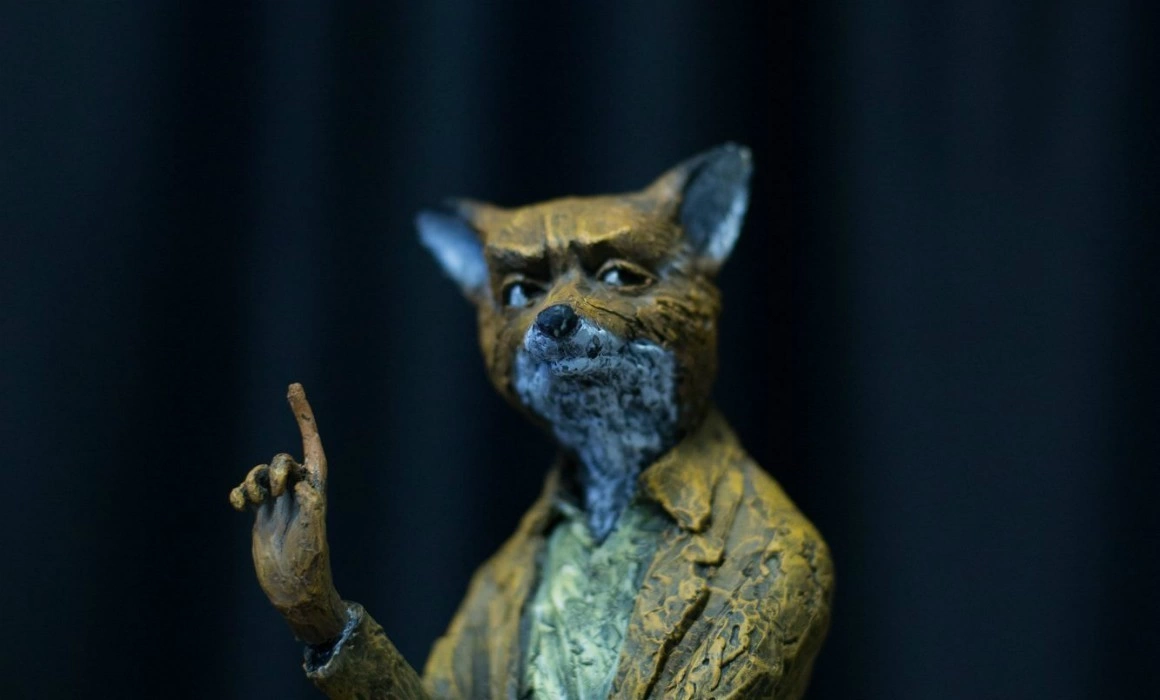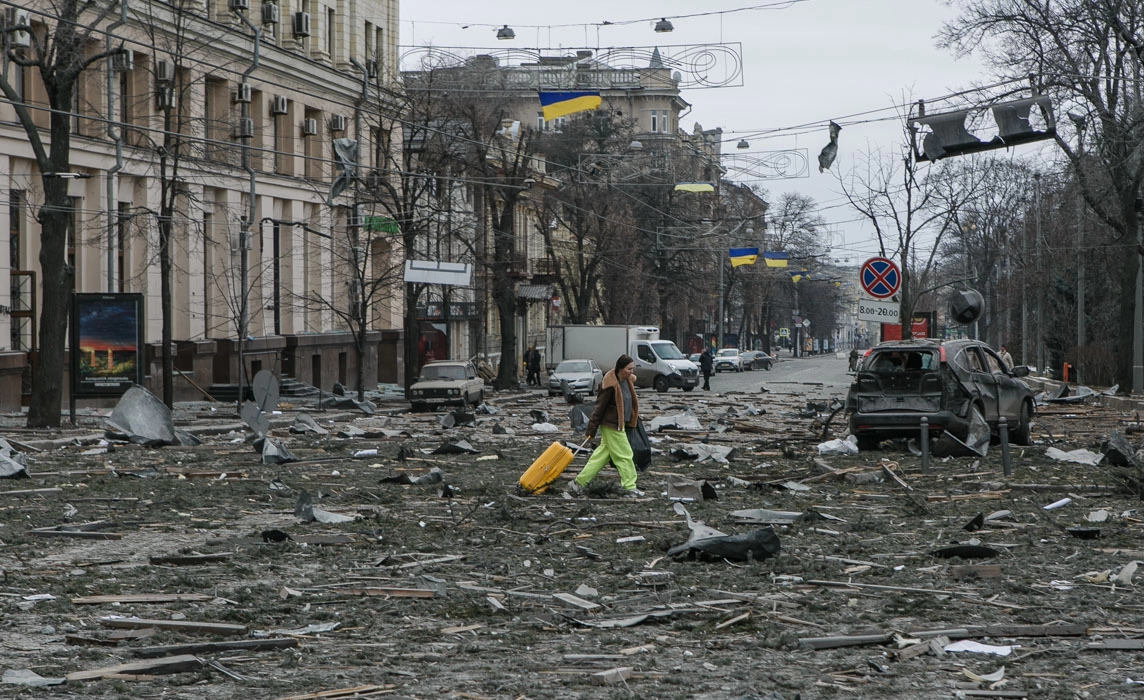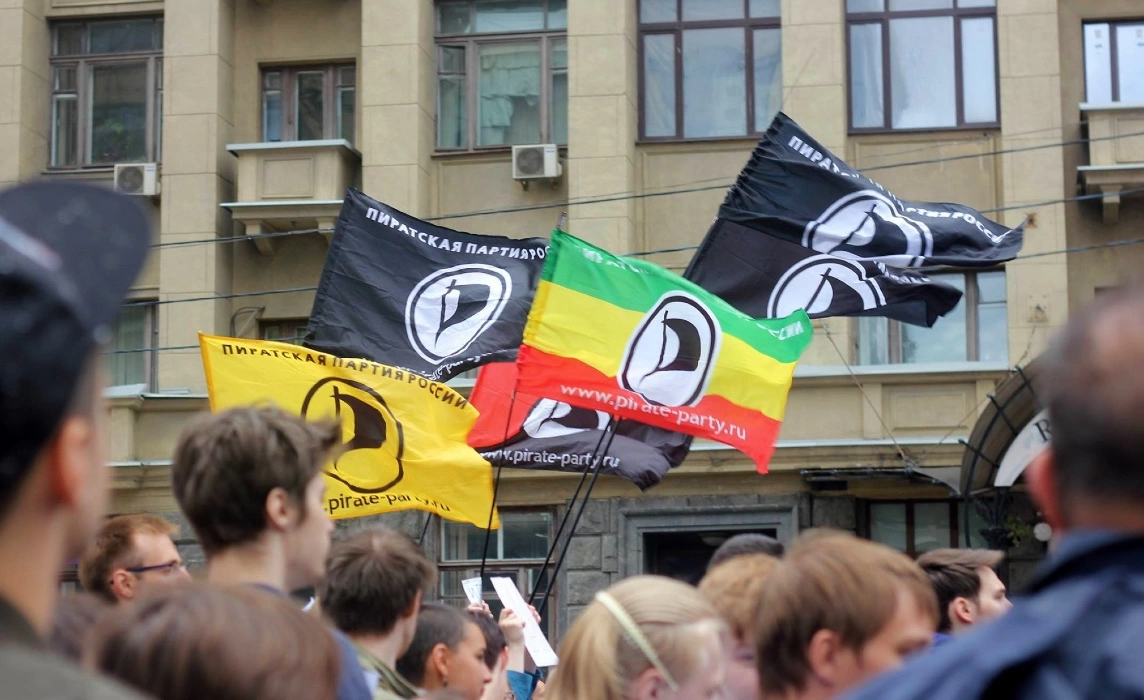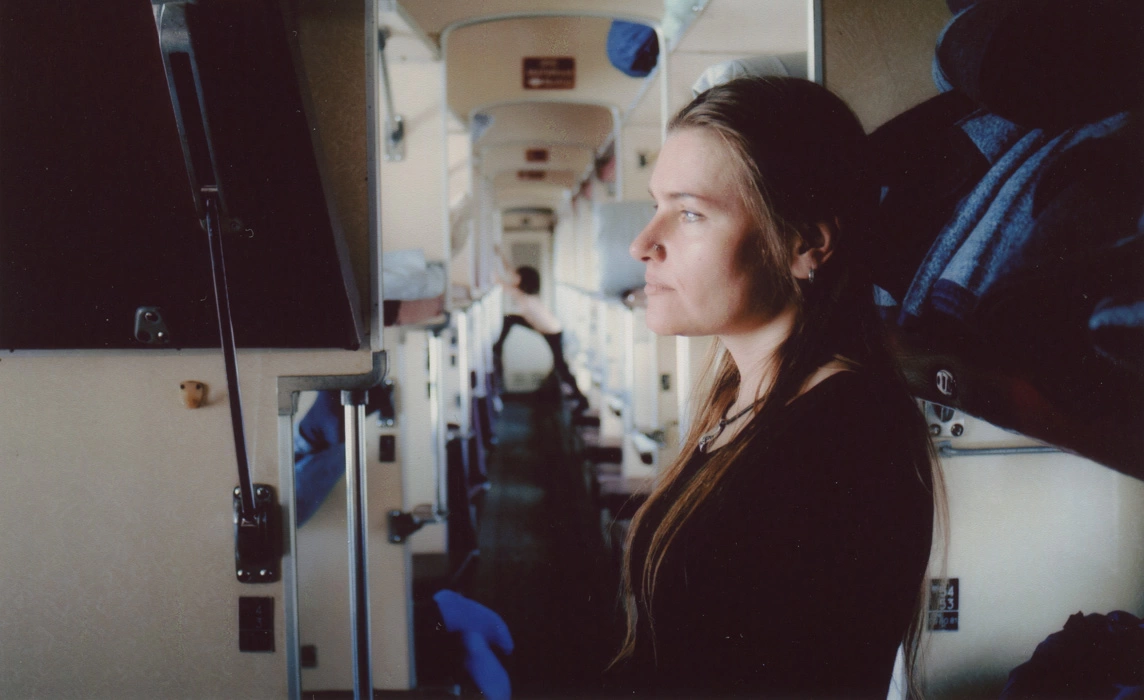It was drizzling and the sky was dark on a Friday evening in the middle of October, when a snazzy fox sneaked inside the new International Center for Research And Education in Innovative Creative Technologies – CINETic (Centrul Internațional de Educație și Cercetare în Tehnologii Creative – CINETic). “What a long and complicated name”, Mr. Fox would have probably said to himself. His name is simple and easy to remember. He’s the fantastic Mr. Fox and he came to prowl Anim’est, the animation film festival that reached its 11th edition in 2016.

Fantastic Mr. Fox (2009) is a movie with an impressive pedigree: it is considered one of the best animations of all time. It is a unique gem (the only animation) in Wes Anderson’s display case that’s filled with retro trinkets and candor. It’s a stop motion adaptation of one of the darkest children’s books written by Roald Dahl (Charlie and the Chocolate Factory, Matilda, The Witches). It’s also sweetened by Anderson’s twee-hip American style, and it’s complete with lessons about diversity and how to be yourself.
Fantastic Mr. Fox takes places in a magical world of anthropomorphized animals, where the father-fox is forced to take one last stab at the world he left behind, that of looting. He ends up risking his life and his family because of three evil farmers: Boggis, Bunce, and Bean. Mr. Fox is George Clooney, and his wife is Meryl Streep. Also featured in the movie are Bill Murray, Jason Schwartzman, Willem Defoe, Pulp’s Jarvis Cocker, Adrien Brody, and Owen Wilson. Anderson fetishizes his collaborators – he rarely works only once with the actors whose names come up first during his movies’ credits. And now we’re getting closer to the reasons Foxy traveled to Romania’s capital.
Mr. Fox was brought to Bucharest by one of his numerous parents: animator Anthony Farquhar-Smith. Farquhar-Smith was part of Tim Burton’s London team who worked on Corpse Bride. He also directed and animated plenty of commercials, and one short movie of his own, about ice cream sticks. He was a part of the Anim’est jury and held a lecture at CINETic about Dahl, Anderson, and animation. He’s British, he’s chill and he talks with a smile. His job combines a clockmaker’s attention to details that goes into stop motion animation (where the décor and the character move millimetrically from one photogram to another) with the precision of modern technology (that has helped ease the work that goes into such an animation). Anthony Farquhar-Smith’s profession is that of bringing objects to life and then helping them evoke emotion.
This October, in Bucharest, the animator took the magic out of the fantastic Mr. Fox. He took him apart, piece by piece, wheel by wheel, to help you understand that a movie, which at first glance seems to be a child’s play, is actually complicated adult work.
Mr. Fox’s Fantastic Figures
Mr. Fox stands on the table and looks at the crowd suspiciously. He’s sculpted and measures 30cm, but he’s not what they call animatronic. He has no joints, so he can’t move. He’s not one of the “animations” that were featured in the movie. Still, he’s unique: he was molded after a sculpture only to be used behind the camera.
We’re inside a research center, so Farquhar-Smith gives us a problem to solve. We will be watching one of the simplest scenes in the movie, the one where Mr. Fox wants to go back to stealing chicken again and is talking to Kylie in his office. A simple set, with two chair, and two characters. Find out how many people worked on it and for how many hours.
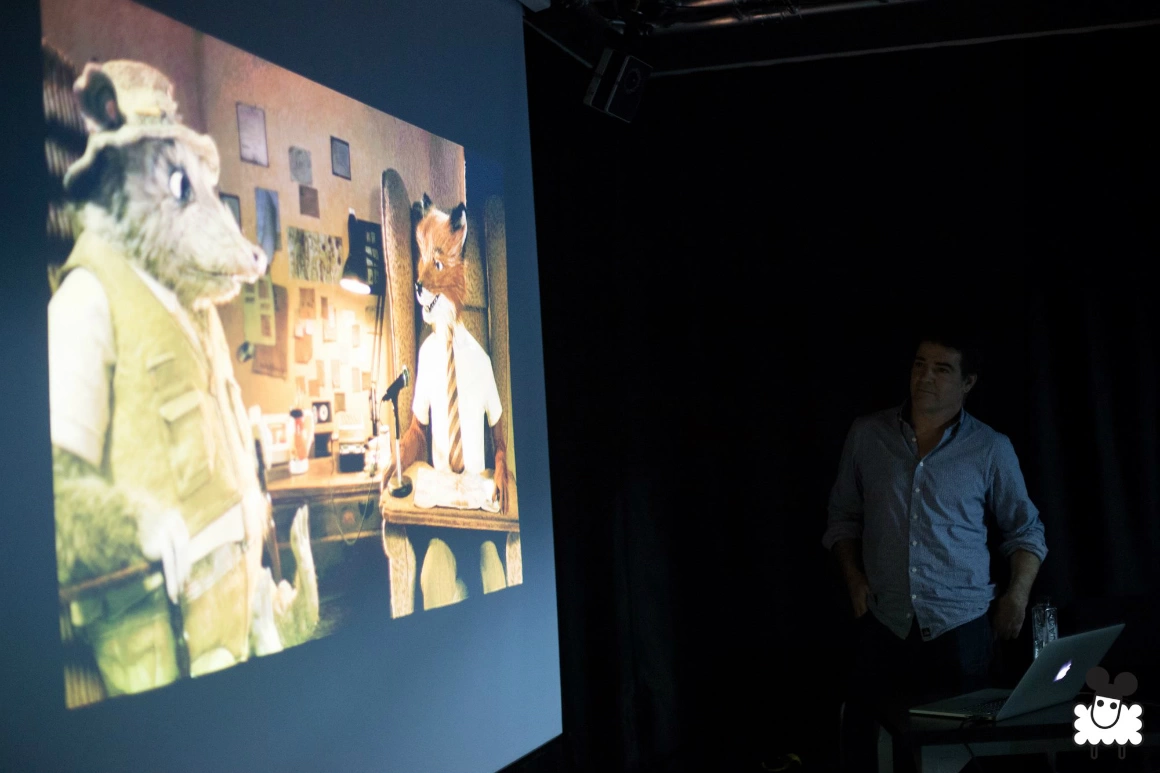
For the entire movie, they used 535 puppets. In total, there are 102 Mr. Fox dolls alone. “One of the craziest jobs that I know”, explains Farquhar-Smith, “is in the puppet department”, where people make what we call the armatures, which are the skeletons underneath the characters’ clothes.
The animator shares that the work for Fantastic Mr. Fox lasted for 14 months, and started with the screenplay. Afterwards, followed the development of the appearance of the movie, and the implementation of it all. Anderson and Noah Baumbach wrote the screenplay in Roal Dahl’s own house, Gipsy House, and the interiors featured in the movie hint to this. The movie is fall-colored, in yellow, brown, beige, and orange – the only cold shades and blues appear in Kristofferson’s suit, Mr. Fox’s nephew who came to visit from abroad.
The development artists are the first ones who get involved in the production process, as they do creative drawings. Once those are approved, they go the draughts people, who do technical drawings and who help translate them into pragmatic projects. Then the carpenters come in, who build the miniature set, and then a whole ‘nother department manually paints it. These are the artists who make objects look like metal, wood, plastic, or whatever else you need. (And when you work with Wes Anderson, you need to be a master at your trade: for this film, the director asked for miniaturized sand, with a very fine granulation.)
While the set is built, the sculptors make the molds for the characters and a different department uses them to create tangible dolls, like the fox brought at CINETic. Then, a person with the costume department knitted all the sweaters that appeared in the movie: Ash’s white ones, Rat’s striped sweaters, as well as Mr. Fox’s beige ones. They were made with wool that measured one eighth of normal size, as were the knitting needles used. Mr. Fox alone has 17 outfits, each of them made in 6 different sizes, to fit all the dolls used in production. Farquhar-Smith doesn’t miss the chance to explain how obsessed with details Wes Anderson is: he wasn’t happy with the initial solutions provided for Mr. Fox by the costume department, so he asked his personal tailor to send him fabrics for the character. In a way, Mr. Fox, the retro-geek-chic fox, is wearing Wes Anderson’s clothes.
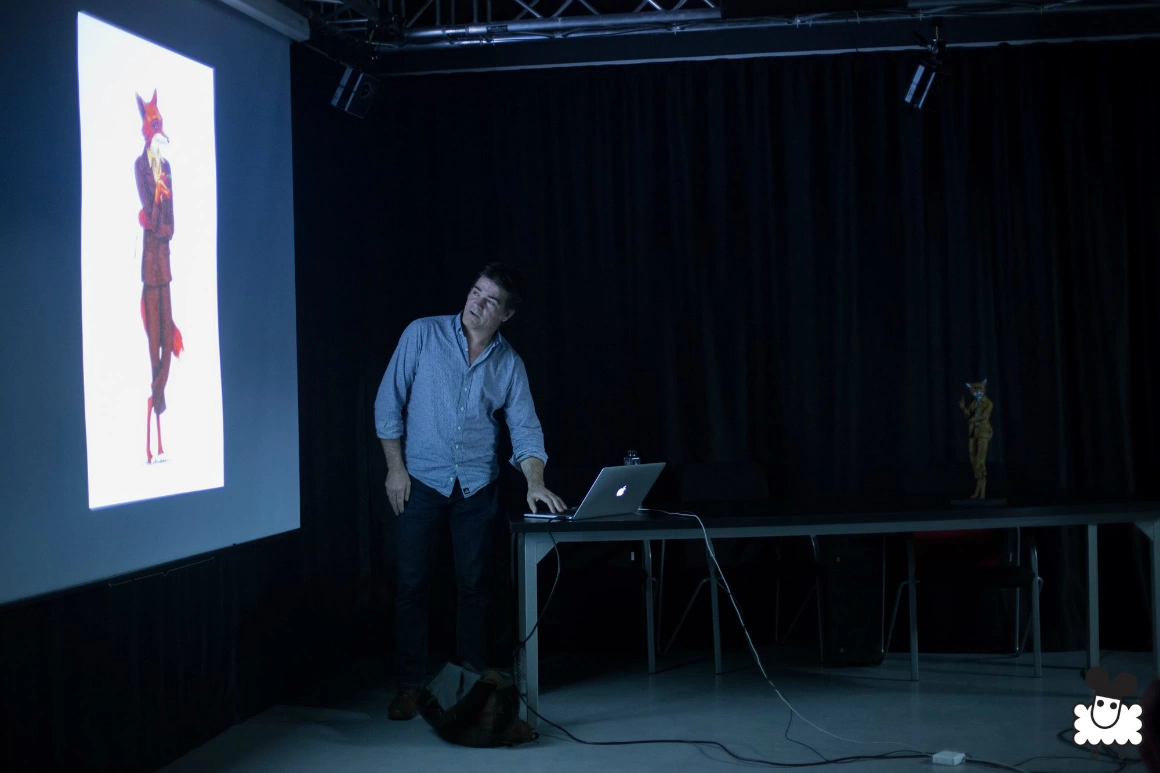
Mr. Fox Comes to Life
After all the details are set, they start to come to life with the help of other departments. For example, one of them is made up of two people who only did rigs: mechanisms that help bring to life various elements in the movie (smoke clouds, tree crowns, and so on) in order to make the animators’ life easier. Then there is the lighting department, the animation – but Farquhar-Smith can’t tell me how many they actually were, but he shows me photos. In one of them, the whole set is photographed from above and you can see such a tiny person in one corner, just to get a glimpse of what we’re talking about. In another one, you can see all the departments together. There have to be a few hundred people, maybe three, maybe four.
There are plenty of them, I remark while I talk to Farquhar-Smith over coffee right next to Cinema Pro. It’s a rainy day, as rainy as the one when he introduced Mr. Fox. There are plenty of them and they are all highly skilled people in the miniature trade. The animator gives me an example of the Corpse Bride characters’ heads. They were around 15mm tall, but they were full of wheels and mechanisms. “Looking into them was like looking inside a Fabergé egg— it was made by people with the same skills as jewelers, silversmiths, and metalworkers.” Is stop-motion animation saving some of the particular crafts it uses? Farquhar-Smith says it isn’t, as there has always been craft in filmmaking. It’s just that stop-motion animation makes things a whole lot more complicated, because it deals with miniatures.
Despite all that’s been said, crafts really have started to lose ground. The famous Laika animation studio isn’t using manual techniques anymore, but a technique called “rapid prototyping”. In other words, they 3D print everything, so that the characters’ facial micro-expressions have a wider range, and are easier to make. But it’s taken something away from the craft, he says. “When you watch Up!, or Finding Dory, as beautiful as it is, there’s still something in you that knows that doesn’t exist. It’s totally being created somewhere and you can’t pick it up? You can’t grab it and look at it. You’ve always got to look at a Pixar movie through a screen. Whereas, when you look at a film like Fantastic Mr. Fox, you see it, you know that, somewhere, that stuff exists. And that’s why I think we’ll outlast computers!” (Laughs)
Computers help ease the work that would otherwise be Sisyphean. It is on this subject that Farquhar-Smith keeps giving examples. At his CINETic lecture, he presents a time-lapse of the work he puts in for a single shot. His shirts change every few seconds: he’s worked for 13 days. For a single shot. He never wants to go through that ever again, but Mr. Fox, or Wes Anderson, to be more precise, gave him no other choice. For the cellar sequence, with the cider bottles, they actually used 200 miniature bottles filled with the golden apple beverage. They initially thought they would work for 10 weeks on it, but because not even Wes Anderson knew exactly what he wanted, it took six months to finish.
It is the computer that allowed him to understand what goes on inside Anderson’s head. Before computers, an animator worked for days on end to transpose a single facial expression on his character – only to find out from the director that was not what he needed. For Fantastic Mr. Fox, they worked with LAVs, which is short for live action videos. The animators, the actors and the director himself, play out a scene in front of the camera, to convey the right emotion. It only takes about 20 minutes to film and then you know for sure that you’re animating exactly what needs to be animated.

What was it like to animate the characters after shots Wes Anderson took of himself, acting out the scenes? The animator laughs and tells me: “I don’t know if Wes wouldn’t mind me saying this, but he’s not an actor. (…) Sometimes, Wes’ videos were useful. Sometimes they were less useful.” He mentions two of his favorites. One, where Anderson was working with 23 animators at once and they were filming first thing in the morning, before the team started working. Wes was in a dressing gown with red slippers holding a kitchen knife, doing Rat’s West Side Story-esque dance routine. The first thing he says to the camera, before he starts, is: “I’m not a dancer, but it’s something like this.” And then he skips around in his slippers.” And another favorite, in which Wes says: “This is what I want in the performance” and then he basically does nothing. He just sort of sits and looks at the camera and does nothing.” Farquhar-Smith says that sometimes, you end up asking yourself how useful is that type of instruction. “And you think, “Thanks, Wes. Cheers!”
But you have the computer. If you don’t understand something from this type of shoot, you can talk to the director right away. The computer is an excellent tool that can help you solve a mathematical equation or create a Pixar movie. It’s a very useful reference, says Farquhar-Smith, and not a threat. Besides, even if we’ve got the computer, people still paint, take photographs, make prints, sculpt. He explains that stop-motion animation is older than cinematography itself. Before people understood how a camera worked, they understood that if you took a photo of an object and then you moved something and you took another photo, you created the illusion of movement. “So, I like to think that, because we were there the earliest, we’re going to end up being there the latest.”
The democratization of the access to technology somehow eliminated the issue of money; money that you need to create such an animation. I mean, you’re not going to create something similar to what Tim Burton or Wes Anderson do, but think of the stop-motion animations that were created by the countries behind the Iron Curtain. Jan Švankmajer is perhaps one of the most influential directors of the genre. The movies from the former republic of Czechoslovakia, as well as the ones in the USSR were sources of inspiration for animators such as Farquhar-Smith, simply because they managed to create magic (as well as include subtle and pertinent political commentaries) with a small budget. Today? “I’m sitting here, looking at cups of tea, a coffee cup, and a wine glass. There’s your characters. Write a script based on the things that are on this table. Then, you make your film” with your phone, with the help of the many apps for stop-motion animation that are available on the market. He tells me how he wanted to make a movie inspired from wood laser cuttings. He eventually did it with ice cream sticks. Unlike the laser, they were only 4 euros for one hundred pieces.
Mr. Smith, Beyond Mr. Fox
Despite pressure from a Tim Burton or a Wes Anderson to focus on complexity and details, Anthony Farquhar-Smith likes to keep it simple when it comes to his movies. “The whole of filmmaking is troubleshooting. Pre-production is basically sitting down and figuring out where everything is going to go wrong. And trying to not let that happen. And, then, when you’re in production, when you’re in the studio, things are going to go wrong. But, hopefully, you’ve thought about them enough, so you’ve got the Plan B you can go to, when everything starts going awry. (…) It is complicated. It’s a jigsaw puzzle that doesn’t actually have all the right pieces when you buy it.”
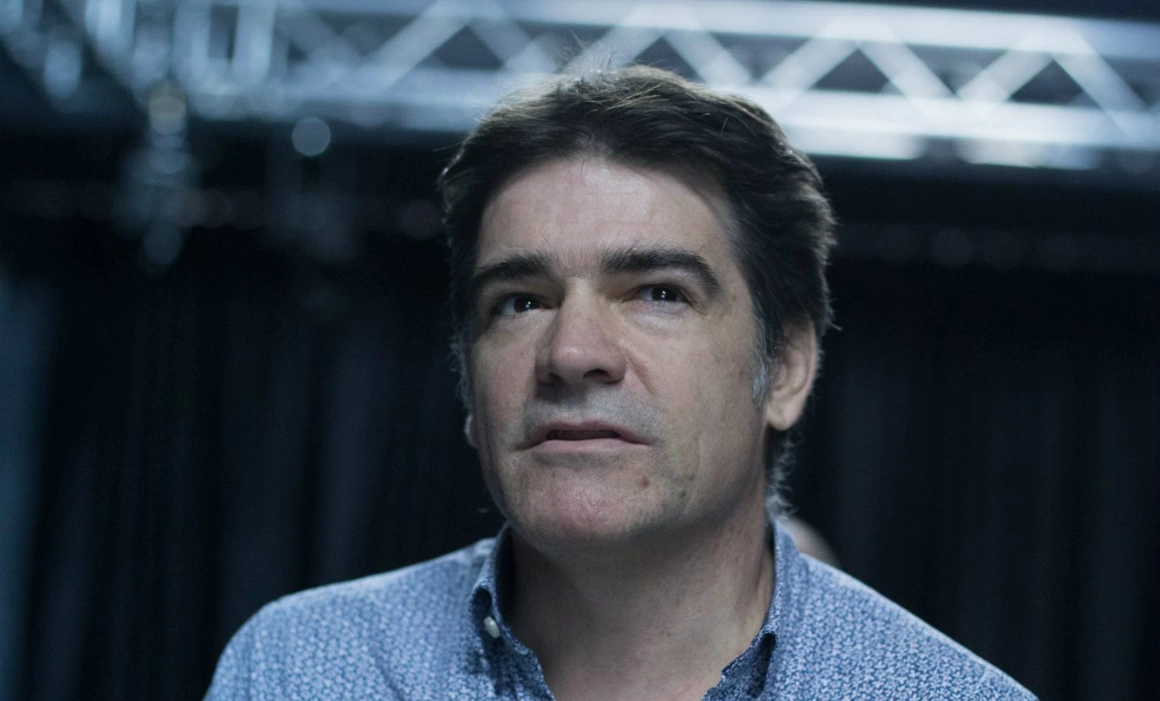
And Farquhar-Smith insists that he's just one of all those pieces,. “It’s very flattering and very nice of you to come and talk to me about my work on Mr. Fox. But I was one of—from when the rights to the film were first acquired to the premiere night — I’d say there were at least 300 people who’d had something to do with that film. During the shoot, there’s at least, 150-170 people there, doing something. So, I’m the 170th part of that film.”
He says that for such a complicated machine, you need to be all in from the beginning. You’re either all in, or you quit. Stop motion animation works just like a traveling circus, says the animator. “There is only a small number of people who can do this work. And once they’ve done a couple of films, they’re suddenly the most experienced people in this particular niche, in this tiny slice of the industry. I know Wes is back in London now and I know he started crewing up with the majority of the Mr. Fox animators. You only have to look at his live action movies to see that he does that quite often, as well. He likes his traveling band.”
It’s a small world, do people fight? Are egos hurt? “When you’re shooting and there’s that pressure and then someone comes in and says ‘Get this done by the end of the day’, of course you resent them a bit. But that’s built from the world, it’s not from the person they are. The pressure is construed from your work atmosphere.” At the end of the day, says the animator, you either shrug and accept that it all comes with the job, or you go home.
As he makes “children’s movies”, I asked him how he would explain his job to a five-year-old. He laughs and says that he couldn’t. He tried to explain it to his nephews, but they didn’t get why he’s not on the big screen, in the movie. They couldn’t understand that he worked on the process that brought those characters to life. He tells me that many years ago he filmed an Aphex Twin clip, at a kindergarten. “The kids were pre-school, so they must’ve been about 5 or 6. When we were in the costume, they referred to us as Mr. Green Bear, Mr. Orange Bear, and Mr. Yellow Bear. And then we would take off the heads and they’d completely dissociate that we were in the teddy bears. They’d go, “Who are you?” I think it’s the same thing when you want to describe to someone the animation process. I guess it’s the same as if you try to describe to someone the process of animation: there’s a puppet and it’s moving and it’s because of me. And they’re like, “But why can’t I see you?”
I ask him what the hardest part about his job is. Nothing, he says. Nothing is so hard that it could make him quit. The hardest thing changes daily: sometimes it’s getting the eyebrow in the right place, getting that expression that shows a certain emotion. To understand what the hell Wes wants from you today. He tells me that he’s working on a short about a padlock. “And it’s not like a padlock that I’ve stuck a face onto, it’s a padlock. I have to show its emotions, I have to show it happy, or sad, or confused… How do you do that? That’s the challenge. That’s the hardest part of my job: making sure that if I move this padlock in a certain way, everyone looks at it and says, “Oh, that’s a happy padlock.” And I need everybody to say that, so that there’s no confusion.”
*
Photos via Anim'est. Alex Lungu contributed with reporting about the conference „Stop Motion, Roald Dahl, and Wes Anderson”.
Translated from the Romanian by Cristina Costea.
